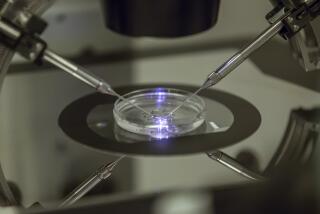Switched-at-Birth Mystery Grows More Complex
- Share via
They could not believe what they had heard. They would trust in their eyes only.
So it took a photograph--of a stranger whose features seemed so achingly familiar--to convince the Chittums, a central Virginia family, that something unbelievable had happened in a Charlottesville hospital three years ago.
The newspaper photo of Paula Johnson was unmistakable in its similarity with 3-year-old Rebecca Grace Chittum. They had the same soft face, the same fair features--proof positive to the Chittums that a foul-up in a hospital maternity ward in 1995 had left them and Johnson with the wrong daughters, an error that now poses a Solomonic dilemma for the state’s medical and legal systems.
“We didn’t want to accept it,” Mary Watts, an aunt of one of the girls, said Monday. “The picture made us believers.”
The mystery of how Rebecca Grace Chittum and Callie Marie Johnson were switched as infants was complicated enough when it was first disclosed late last week by officials at the University of Virginia Medical Center. Chief of Staff Thomas Massaro reported that the hospital was unable to explain how the mix-up occurred. Insisting they had taken proper precautions and concluding the switching was a criminal act, Massaro said hospital officials have requested an investigation by Virginia State Police.
But the uncertain prospects looming before the two children grew more byzantine as relatives reported Monday that Kevin Chittum, 25, and girlfriend Whitney Rogers, 19, the parents of one of the switched girls, had died along with five others in a highway car wreck July 4.
The lack of one set of natural parents--and the possible intrusion of relatives and likely involvement of lawyers and judicial officials--threaten to thrust the case of the two little girls into a realm unique in the annals of family law.
“I’m wondering how any judge would approach it,” said Betty A. Thompson, an Arlington, Va., attorney and state bar official. “It’s not a set of facts you’re going to find easy precedents for.”
One complication will be the role of the hospital. Although rare, instances of baby-switching have cropped up over the years. The most celebrated in recent years was that of 14-year-old Kimberly Mays, a Florida teenager who was switched at birth, then waged a court battle in the early 1990s to remain with her adoptive parents despite efforts by her natural parents to win her back.
Most hospitals take precautions to ensure infants end up in the arms of the proper parents. For decades, maternity wards have banded the wrists of mothers and children with identity bracelets and taken footprints, photographs and physical assessments. In recent years, computer charts have added to the wealth of information.
“It’s unfortunate when this occurs, but it happens so infrequently,” said Edward Flores, associate director of security at NYU Medical Center in New York and president of the International Assn. for Health Care Security and Safety. When identities are switched, Flores noted, it is almost always “human error.”
University of Virginia hospital officials said they had taken all of those precautions during the births of Rebecca and Callie Marie. But Paula Johnson, who discovered something was amiss when a custody dispute DNA test led her to realize Callie Marie was not her biological child, has told friends that her birth daughter was not given proper wrist and ankle identification bracelets. Hospital officials deny that claim.
For the moment, Watts said, what the parents and guardians of the two children plan to do is being kept under wraps by lawyers. “The last thing I heard is that the grandmom is going to try and keep Rebecca,” Watts said of Rosa Lee Chittum, Kevin Chittum’s mother. Paula Johnson, 30, reportedly wants to keep Callie Marie, even though Rebecca appears to be her natural daughter.
But snags could lead to a courtroom. Some Chittum relatives have talked of trying to take custody of Callie Marie, said Watts--who also would like to see the children returned to their biological families. Paula Johnson’s custody battle further complicates the picture.
“What this will turn on is what’s in the best interest of the children,” Thompson said.
And in that, the case may be less an oddity than an extreme version of the fracturing of the American family.
“Families just aren’t as intact as they used to be, and the legal system has become more flexible in dealing with that,” Thompson said. “What you see today is more joint legal custody and when you have families on both sides making strong cases for custody, that’s the direction judges like to go in. I wouldn’t be surprised to see that kind of resolution in this case.”
More to Read
Sign up for Essential California
The most important California stories and recommendations in your inbox every morning.
You may occasionally receive promotional content from the Los Angeles Times.













